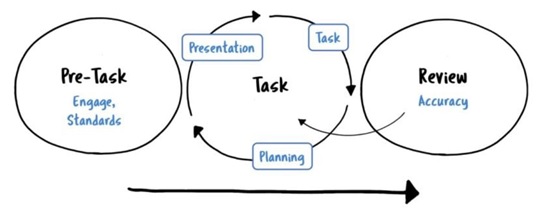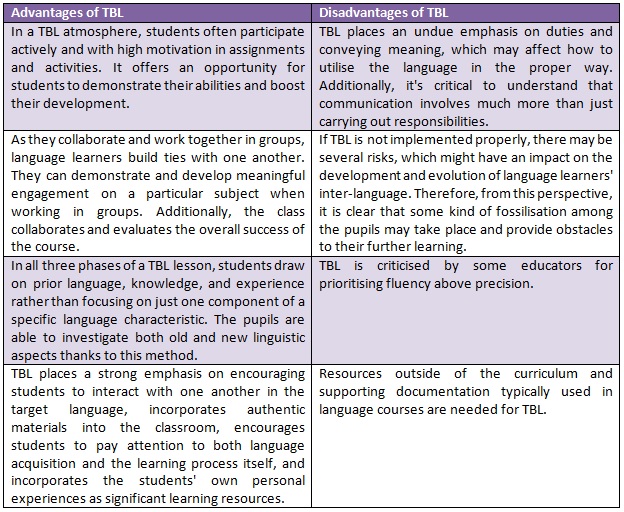In task-based learning (TBL), the emphasis is on using real language to carry out important tasks in the chosen language. These duties can involve going to the doctor, going on an interview, or contacting customer service. Instead than relying heavily on the accuracy of the prescribed language forms, assessments are mostly based on task outcomes (the proper performance of real-world tasks). This makes TBL particularly well known for fostering student confidence and fluency in the target language.
As the name implies, the task is the central component of the assignment. Teachers and curriculum designers should keep in mind that any focus on form, such as grammar or vocabulary, raises the possibility that students will be diverted from the work at hand and instead spend their time identifying and correcting errors, looking up words in dictionaries, or otherwise becoming fixated with grammar and vocabulary.
The following is a general outline for developing a task-based lesson:
- Pre-Task
- Task
- Review
Presentation, practice and production (PPP):
The PPP technique consists of three stages that most individuals who have learned how to do something would be familiar with, making it a widely accepted approach of teaching.
Presentation: In the first stage, a linguistic feature is introduced in a situation that is recognisable to the pupils, similar to how a swimming instructor might show a stroke to a beginner outside of the pool.
Practice: In this stage students are given a task that provides them with numerous opportunities to use the new language feature and become accustomed to it while receiving minimal and appropriate teacher aid. Like for an instance, the swim coach would let the kids practice the techniques in the water while remaining nearby to offer any necessary support and lots of encouragement.
Production: The pupils will utilise the language in context during the final stage, where the teacher will provide only limited guidance, much like a swimming instructor who lets his young students make their first hesitant strokes on their own.
It takes more time, and there is a chance that the learner won't learn the grammar implicitly (when using inductive teaching), which could cause the student to lag behind in their growth. However, the final step of TBL concentrates on form and has a language component, which can need a more logical strategy.
How can a task-based approach be used in your classroom?
You cannot skip the "boring stuff" as an English teacher, such as vocabulary exercises and grammatical drills. Additionally, take into consideration that your children must practise speaking, listening, reading, and writing.
However, by limiting the amount of drills and language activities and incorporating more task-based learning into your curriculum, you may encourage students to utilise the target language right away and improve their retention of vocabulary and grammar.
Following are two illustrations of task-based lesson plans:
For in-class batches:
Warm-up and introductions: Play a song that is popular among your pupils while they are settling in. If they are familiar with the music, you may let them sing along!
Give instructions and assign the work: “Produce your own music video using a song of your choosing in groups of students. Everyone must play a part, whether it is handling the camera, creating the choreography, or acting in the film. This lesson is for planning, and the following lesson is for filming. In the third lesson, we'll view all the videos and exchange feedback with one another.”
Take action: Allow pupils to organise into groups and begin developing their videos. Take notice of their verbal and cooperative behaviour. Make sure that no pupils are idly watching and that everyone is actively participating.
Review: Before the class is over, offer the kids some clarity, encouraging comments and thank everyone for their contributions and language use. Remind the pupils that filming will begin in the upcoming lesson.
This can be followed for at max a group of 10 to 15 teenagers.
For online classes:
Warm-up and introductions: Each student's name will be called out when you hand them a paper with a new word on it. For example, it may be "cat," "run," "man," "rainy," or "lady." Each student should read their contribution aloud.
Give instructions and assign the work: “Write a short tale using every single word just given to you. You have control over the words' positioning in your tale as well as their utilization. You are free to use as many words and story turns as you like. At least one sentence must be contributed by each student. Please begin.”
Take action: Take notes while watching the students on video. If they are unable to communicate with one another, you can offer some assistance by posing queries such, "What do you think could happen next?" Alternatively, you may ask, "Who can think of the following idea?" or "Who wants to add their word next?" Without immediately providing them with an idea, your encouragement should persuade the pupils to join. Finally, ask the kids to record the narrative they came up with. Then, one phrase at a time, they can alternate reading it aloud.
Review: Appreciate your pupils' efforts and collaboration while praising their narrative. Give the children some time to reflect on their own performance and answer questions such, "What did you do really well today?" or "What do you want to modify for the next time?"
This can be followed only for a group of 4 to5 young learners.
Advantages and Disadvantages of Task Based Learning:


Conclusion
The fact that TBL is typically inductive and PPP is deductive is a significant distinction between the two methods. The key characteristics of a deductive method are that it is teacher centered and direct because the learner has little space for interpretation. The learners are engaged and valued through an inductive approach. Consider in-class 120 hours TEFL course for getting yourself prepared for TEFLing!
Happy Learning!
Written By : Sudeshna Guha Thakurta















